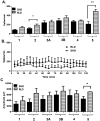Advantages of repeated low dose against single high dose of kainate in C57BL/6J mouse model of status epilepticus: behavioral and electroencephalographic studies
- PMID: 24802808
- PMCID: PMC4011859
- DOI: 10.1371/journal.pone.0096622
Advantages of repeated low dose against single high dose of kainate in C57BL/6J mouse model of status epilepticus: behavioral and electroencephalographic studies
Abstract
A refined kainate (KA) C57BL/6J mouse model of status epilepticus (SE) using a repeated low dose (RLD) of KA (5 mg/kg, intraperitoneal; at 30 min intervals) was compared with the established single high dose (SHD) of KA (20 mg/kg, intraperitoneal) model. In the RLD group, increased duration of convulsive motor seizures (CMS, Racine scale stage ≥3) with a significant reduction in mortality from 21% to 6% and decreased variability in seizure severity between animals/batches were observed when compared to the SHD group. There was a significant increase in the percentage of animals that reached stage-5 seizures (65% versus 96%) in the RLD group. Integrated real-time video-EEG analysis of both groups, using NeuroScore software, revealed stage-specific spikes and power spectral density characteristics. When the seizures progressed from non-convulsive seizures (NCS, stage 1-2) to CMS (stage 3-5), the delta power decreased which was followed by an increase in gamma and beta power. A transient increase in alpha and sigma power marked the transition from NCS to CMS with characteristic 'high frequency trigger' spikes on the EEG, which had no behavioral expression. During SE the spike rate was higher in the RLD group than in the SHD group. Overall these results confirm that RLD of KA is a more robust and consistent mouse model of SE than the SHD of KA mouse model.
Conflict of interest statement
Figures







References
-
- Rattka M, Brandt C, Loscher W (2012) Do proconvulsants modify or halt epileptogenesis? Pentylenetetrazole is ineffective in two rat models of temporal lobe epilepsy. Eur J Neurosci 36: 2505–2520. - PubMed
-
- Bankstahl M, Muller CJ, Wilk E, Schughart K, Loscher W (2012) Generation and characterization of pilocarpine-sensitive C57BL/6 mice as a model of temporal lobe epilepsy. Behav Brain Res 230: 182–191. - PubMed
-
- Raol YH, Brooks-Kayal AR (2012) Experimental models of seizures and epilepsies. Prog Mol Biol Transl Sci 105: 57–82. - PubMed
-
- Loscher W (2002) Animal models of epilepsy for the development of antiepileptogenic and disease-modifying drugs. A comparison of the pharmacology of kindling and post-status epilepticus models of temporal lobe epilepsy. Epilepsy Res 50: 105–123. - PubMed
Publication types
MeSH terms
Substances
Grants and funding
LinkOut - more resources
Full Text Sources
Other Literature Sources

